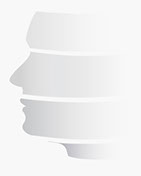Frequently Asked Questions
How can I tell if I have a sinus headache?
Most people that self diagnose their headaches as sinus headaches really have migraine headaches (over 90%)! Migraines often cause sinus pain and congestion and even nasal or post nasal dripping and discharge. If you answer yes to two out of three of the following questions then you most likely are suffering from migraine and it may be better to take a CT of your sinuses than to take repeated courses of antibiotics:
In the last 3 months have you missed work, school or family functions due to these headaches?
Are you ever light sensitive with these headaches?
Are you ever nauseous with these headaches?
Is caffeine good or bad for headaches?
The answer is yes. If you have a headache and you can keep your daily consumption to less than 100mg of caffeine it may help the analgesic you take to get rid of the headache quicker and more effectively. However, when you do not have a headache, caffeine can trigger a headache! Also the main symptom of caffeine withdrawal is headache and this has been shown to occur at as little as 100mg of caffeine per day. Caffeine may contribute to rebound headaches as well but this is less well understood. Caffeine by itself does not help headaches unless they are caffeine withdrawal headaches.
How do I know if I have a brain tumor and do I need an MRI?
Most headaches are not caused by tumors and brain scans rarely reveal the cause of even severe disabling migraines. Headaches due to tumors do not come and go but worsen with time and more than 90 % of the time cause other neurologic signs or symptoms as well as the headache. Aneurysms can cause sudden onset of severe headaches that can mimic migraines and when this happens for the first time in a patient without a previous headache history then a scan may be necessary. However, the need for a scan will still be based an evaluation of the history, exam and current complaint.
Is it better to treat my migraine right away or just try to tough it out to avoid taking so many medicines?
And, how do I know if this headache is a migraine?
Treating a migraine in the first 10-20 minutes will greatly increase the chances that the headache will go away with less medicines. Often migraines, as they worsen, will cause nausea which is due to the migraine causing the stomach not to work. This means that migraine medicines taken orally may not absorb and therefore not work well or at all. Migraines can also worsen throughout the day and then may be harder to reset by sleep and this may increase the chance of getting a migraine the next day as well. Also, most of the headaches that migraine patients get are migraines and deserve prompt treatment. The level of pain is not the only determinate of a headache being a migraine. The counter balance to the above advice is that it is easy to develop medication overuse headache (MOH) if you find you are taking abortive medications more than two days per week.
What are rebound headaches?
Rebound headaches (more officially called medication over-use headaches (MOH) ) are headaches that increase in severity and frequency due to taking excessive abortive medications. Just about any abortive medicine can cause this problem, however, narcotics and butalbital (Fioricet) are the ones that do it the quickest ( in as little as taking these drugs more than 4-6 days per month). Simple analgesics such as most OTC non-combination drugs are the slowest to cause MOH, requiring greater than 12-15 days per month.
Do children suffer from headaches too?
When asked whom you think of going to the doctor for having a bad headache, you most commonly think of adults. But many kids have headaches, too. Children and teens (especially teenage girls) can experience tension-type or migraine headaches. Among school age children ages 5 to 17 in the U.S., 20% are prone to headaches. Two thirds of these kids experience tension-type headaches and the rest are coping with migraines (that is over 3 million children with migraines). Grade school children may experience a migraine as more a “sick stomach” that causes them to lie down then a severe headache. As they get older, they can start to experience headache too.
Why are there so few good tools for headache prevention?
The National Institute for Health (NIH) spends on average only about 10-13 million dollars per year on various headache disorders yet it is estimated that migraines alone cost the United States some 30-50 billion dollars per year in direct and indirect costs. If the social and economic burden where used to apportion the NIH budget, headache disorders should receive in excess of 100 million dollars per year or 10 times the current budget level. Some have commented that women bear most these costs and maybe this lack of funding is due to sexist tendencies of our world. Whatever the reason, you should contact your representative or senator to express your desire for fairer funding of this very disabling disease.
